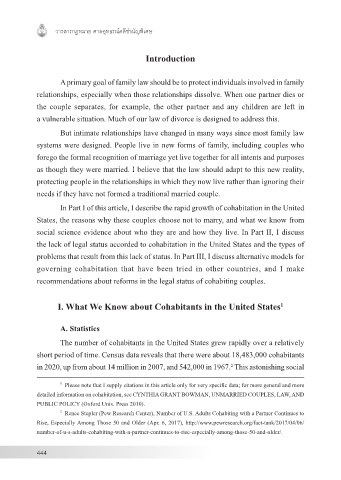Page 446 - วารสารกฎหมาย ศาลอุทธรณ์คดีชํานัญพิเศษ
P. 446
วารสารกฎหมาย ศาลอุทธรณ์คดีชำานัญพิเศษ
Introduction
A primary goal of family law should be to protect individuals involved in family
relationships, especially when those relationships dissolve. When one partner dies or
the couple separates, for example, the other partner and any children are left in
a vulnerable situation. Much of our law of divorce is designed to address this.
But intimate relationships have changed in many ways since most family law
systems were designed. People live in new forms of family, including couples who
forego the formal recognition of marriage yet live together for all intents and purposes
as though they were married. I believe that the law should adapt to this new reality,
protecting people in the relationships in which they now live rather than ignoring their
needs if they have not formed a traditional married couple.
In Part I of this article, I describe the rapid growth of cohabitation in the United
States, the reasons why these couples choose not to marry, and what we know from
social science evidence about who they are and how they live. In Part II, I discuss
the lack of legal status accorded to cohabitation in the United States and the types of
problems that result from this lack of status. In Part III, I discuss alternative models for
governing cohabitation that have been tried in other countries, and I make
recommendations about reforms in the legal status of cohabiting couples.
I. What We Know about Cohabitants in the United States 1
A. Statistics
The number of cohabitants in the United States grew rapidly over a relatively
short period of time. Census data reveals that there were about 18,483,000 cohabitants
in 2020, up from about 14 million in 2007, and 542,000 in 1967. This astonishing social
2
1 Please note that I supply citations in this article only for very specific data; for more general and more
detailed information on cohabitation, see CYNTHIA GRANT BOWMAN, UNMARRIED COUPLES, LAW, AND
PUBLIC POLICY (Oxford Univ. Press 2010).
2 Renee Stepler (Pew Research Center), Number of U.S. Adults Cohabiting with a Partner Continues to
Rise, Especially Among Those 50 and Older (Apr. 6, 2017), http://www.pewresearch.org/fact-tank/2017/04/06/
number-of-u-s-adults-cohabiting-with-a-partner-continues-to-rise-especially-among-those-50-and-older/.
444

